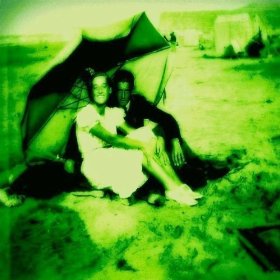 The members of Dead Wolf Club weren’t out of primary school when Pixies called it a day the first time around, or when My Bloody Valentine released the seminal ‘Loveless’, but the influences and legacy of late eighties and early nineties arty alternative/noise rock is deeply rooted within their sound. While Dead Wolf Club’s re-visitation of a 90s alternative sound could draw parallels with the much praised revivalists Yuck and A Place To Bury Strangers – at least in terms of attitude – on their debut album they’re not always as consistent as either. That’s not to say the ideas aren’t there, though – these guys have plenty of inspired musical moments.
The members of Dead Wolf Club weren’t out of primary school when Pixies called it a day the first time around, or when My Bloody Valentine released the seminal ‘Loveless’, but the influences and legacy of late eighties and early nineties arty alternative/noise rock is deeply rooted within their sound. While Dead Wolf Club’s re-visitation of a 90s alternative sound could draw parallels with the much praised revivalists Yuck and A Place To Bury Strangers – at least in terms of attitude – on their debut album they’re not always as consistent as either. That’s not to say the ideas aren’t there, though – these guys have plenty of inspired musical moments.
Behind the brightly coloured origami wolves which adorn the sleeve lies a world of visceral noise, interjected with atmospheres. ‘Wave’, the centrepiece from both this album and the band’s live set, shows DWC at their absolute best. On this mini-masterpiece of swirling anger, a four chord, looping riff has an almost hypnotic appeal, starting slowly and gaining momentum throughout. Eventually, a much weightier riff (recalling early Smashing Pumpkins and Slint) crashes in under which the treated lead vocals are barely audible. The sprawling six minute ‘Colossus’, works its magic via a similarly simple riff, creating a world of general trippiness via various alt-rock and shoegaze influences. The multi-layed guitar parts (courtesy of John Othello and Alwin Fernandez) rise and fall, while Othello’s lead vocal interjects in an echoing fashion, like a man shouting from the end of a long corridor. Looking beyond the twin guitars – fuzzed up and at maximum jangle – Martha’s hard bassline really carries the weight of the tune. While not quite as distinctive as ‘Wave’, this tune represents a more than solid slice of arty indie rock.
On the slightly more aggressive front, ‘Headful of Horrors’ opens with a heady mix of clanging rhythmic chords overlaid with heavily distorted lead guitar and some similarly distorted vocals. Surprisingly, given the DIY approach, there’s still a clear separation between the multi-layered guitar parts, allowing an occasionally used clean lead ample opportunity to ring out above the world of fuzz. A busy drum part underpins the verses of ‘Radar’, but an ugly vocal and uninspiring tune initially suggests this song needed more work. However, something more melodic soon appears over the horizon: a clean-toned guitar bridges the verse and chorus via a great (but all too brief) interlude, while the chorus itself is okay too. By the track’s end, it fares better than initial impressions suggest, but measured against a couple of DWC’s best numbers, though, it’s not a classic by any stretch. ‘Allison’ is even more guttural and basic with most of the song hammered home with a screamy vocal, occasionally backed by a shouting counter-voice. Despite the brief running time, there’s still time for a couple of quieter sections where Martha offers some superb sounding bass. On those quieter parts, for those willing to invest the time it takes to tune in fully, DWC prove the creation of multi-layered soundscapes within even their briefest of numbers is just as important as throwing primal aggression out there.
While some more discerning listeners may detect a slight inconsistency in drum sounds [the album itself having been recorded with three recording engineers/producers and as many different drummers], there are enjoyable results on ‘Dead Wolf Club’. While it may not always capture the levels of anger present during parts of their live set (which is worth catching to see drummer Serra Petale attacking her kit), this independently released disc has a ragged appeal and a bristling energy that captures Dead Wolf Club’s “geek rage” well enough for a first outing.
Listen to or buy the album via the widget below.
July/August 2012




 The Mothership is a four-piece alternative rock/grunge band from Seattle. In March 2011, they released a debut three song EP. That gave a reasonable taster of The Mothership’s sound, but this full length released just six months later, allows the band a longer – if not always broader – canvas on which to show off their talents.
The Mothership is a four-piece alternative rock/grunge band from Seattle. In March 2011, they released a debut three song EP. That gave a reasonable taster of The Mothership’s sound, but this full length released just six months later, allows the band a longer – if not always broader – canvas on which to show off their talents.